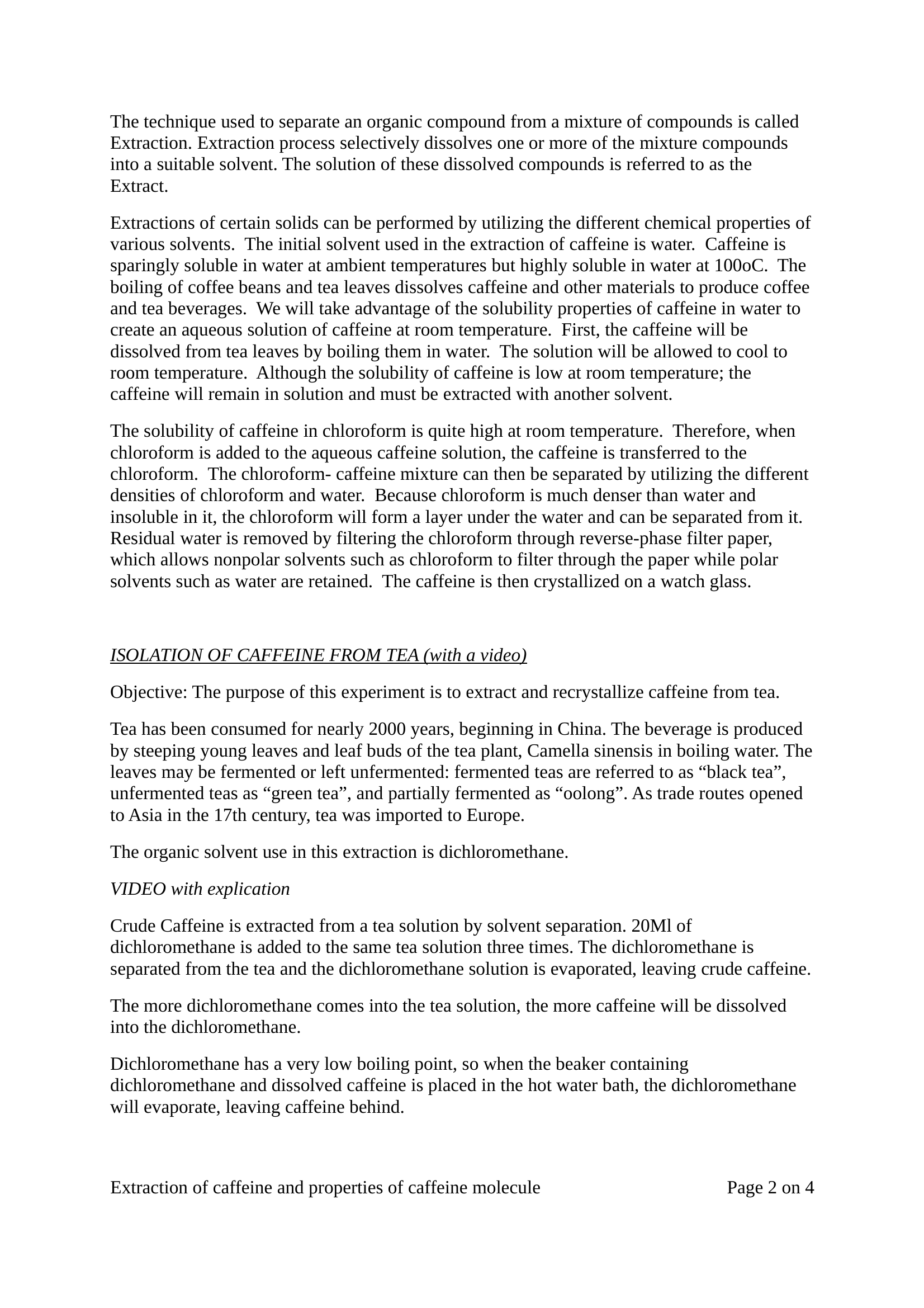Caffeine
Publié le 16/10/2014

Extrait du document
«
The technique used to separate an organic compound from a mixture of compounds is called
Extraction.
Extraction process selectively dissolves one or more of the mixture compounds
into a suitable solvent.
The solution of these dissolved compounds is referred to as the
Extract.
Extractions of certain solids can be performed by utilizing the different chemical properties of
various solvents.
The initial solvent used in the extraction of caffeine is water.
Caffeine is
sparingly soluble in water at ambient temperatures but highly soluble in water at 100oC.
The
boiling of coffee beans and tea leaves dissolves caffeine and other materials to produce coffee
and tea beverages.
We will take advantage of the solubility properties of caffeine in water to
create an aqueous solution of caffeine at room temperature.
First, the caffeine will be
dissolved from tea leaves by boiling them in water.
The solution will be allowed to cool to
room temperature.
Although the solubility of caffeine is low at room temperature; the
caffeine will remain in solution and must be extracted with another solvent.
The solubility of caffeine in chloroform is quite high at room temperature.
Therefore, when
chloroform is added to the aqueous caffeine solution, the caffeine is transferred to the
chloroform.
The chloroform- caffeine mixture can then be separated by utilizing the different
densities of chloroform and water.
Because chloroform is much denser than water and
insoluble in it, the chloroform will form a layer under the water and can be separated from it.
Residual water is removed by filtering the chloroform through reverse-phase filter paper,
which allows nonpolar solvents such as chloroform to filter through the paper while polar
solvents such as water are retained.
The caffeine is then crystallized on a watch glass.
ISOLATION OF CAFFEINE FROM TEA (with a video)
Objective: The purpose of this experiment is to extract and recrystallize caffeine from tea.
Tea has been consumed for nearly 2000 years, beginning in China.
The beverage is produced
by steeping young leaves and leaf buds of the tea plant, Camella sinensis in boiling water.
The
leaves may be fermented or left unfermented: fermented teas are referred to as “black tea”,
unfermented teas as “green tea”, and partially fermented as “oolong”.
As trade routes opened
to Asia in the 17th century, tea was imported to Europe.
The organic solvent use in this extraction is dichloromethane.
VIDEO with explication
Crude Caffeine is extracted from a tea solution by solvent separation.
20Ml of
dichloromethane is added to the same tea solution three times.
The dichloromethane is
separated from the tea and the dichloromethane solution is evaporated, leaving crude caffeine.
The more dichloromethane comes into the tea solution, the more caffeine will be dissolved
into the dichloromethane.
Dichloromethane has a very low boiling point, so when the beaker containing
dichloromethane and dissolved caffeine is placed in the hot water bath, the dichloromethane
will evaporate, leaving caffeine behind.
Extraction of caffeine and properties of caffeine molecule Page 2 on 4.
»
↓↓↓ APERÇU DU DOCUMENT ↓↓↓

































